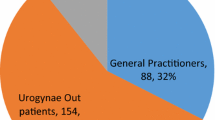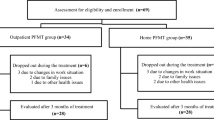Abstract
The purpose of this paper is to assess the efficacy of physiotherapy and quality of life in women treated for urinary incontinence by specialized physiotherapists in daily community-based practices. Three hundred and fifty-five women were treated in five physiotherapy practices between January 2000 and December 2004. After a minimum follow-up of 12 months, these women received a questionnaire at home. With the questionnaire, we collected demographic data, data on the efficacy of treatment, satisfaction with the result, and the Urogenital Distress Inventory, and Incontinence Impact Questionnaire. Additional information was derived from the medical files. One hundred and eighty-seven women responded. Fifty percent of women were satisfied with the result of physiotherapy. After a mean follow-up of 32 months, 123 out of 130 women (94.6%), who only had physiotherapy, recorded to experience incontinence episodes daily to several times a week. Women who underwent additional incontinence surgery after insufficient physiotherapy recorded significantly less urinary incontinence symptoms and a better quality of life. Pelvic floor muscle training for urinary incontinence is effective in half of the women. If not successful, women seem to benefit significantly from incontinence surgery.
Similar content being viewed by others
References
Hunskaar S, Burgio K, Diokno A, Herzog AR, Hjalmas K, Lapitan MC (2003) Epidemiology and natural history of urinary incontinence in women. Urology 62(4 Suppl 1):16–23 (October)
Van der Vaart CH, de Leeuw JR, Roovers JP, Heintz AP (2002) The effect of urinary incontinence and overactive bladder symptoms on quality of life in young women. BJU Int 90(6):544–549 (October)
Ross S, Soroka D, Karahalios A, Glazener C.M, Hay-Smith EJ, Drutz HP (2005) Incontinence-specific quality of life measures used in trials of treatments for female urinary incontinence: a systematic review. Int Urogynecol J Pelvic Floor Dysfunct, July 16
Bo K, Kvarstein B, Nygaard I (2005) Lower urinary tract symptoms and pelvic floor muscle exercise adherence after 15 years. Obstet Gynecol 105(5 Pt 1):999–1005 (May)
Cammu H, Van Nylen M, Blockeel C, Kaufman L, Amy JJ (2004) Who will benefit from pelvic floor muscle training for stress urinary incontinence? Am J Obstet Gynecol 191(4):1152–1157 (October)
Van der Vaart CH, de Leeuw JR, Roovers JP, Heintz AP (2003) Measuring health-related quality of life in women with urogenital dysfunction: the urogenital distress inventory and incontinence impact questionnaire revisited. Neurourol Urodyn 22(2):97–104
Abrams P, Cardozo L, Fall M, Griffiths D, Rosier P, Ulmsten U, Van Kerrebroeck P, Victor A, Wein A (2002) The standardisation of terminology of lower urinary tract function: report from the Standardisation Sub-committee of the International Continence Society. Neurourol Urodyn 21(2):167–178
Van Brummen HJ, Bruinse HW, van der Bom J.G, Heintz AP, Van der Vaart CH (2005) How do the prevalences of urogenital symptoms change during pregnancy? Neurourol Urodyn 20;25(2):135–139 (November)
Alewijnse D, Metsemakers JF, Mesters IE, van den Borne B (2003) Effectiveness of pelvic floor muscle exercise therapy supplemented with a health education program to promote long-term adherence among women with urinary incontinence. Neurourol Urodyn 22(4):284–295
Bo K, Talseth T, Holme I (1999) Single blind, randomised controlled trial of pelvic floor exercises, electrical stimulation, vaginal cones, and no treatment in management of genuine stress incontinence in women. BMJ 318(7182):487–493 (February)
Goode PS, Burgio KL, Locher JL, Roth DL, Umlauf MG, Richter HE, Varner RE, Lloyd LK (2003) Effect of behavioral training with or without pelvic floor electrical stimulation on stress incontinence in women: a randomized controlled trial. JAMA 290(3):345–352 (July)
Jundt K, Peschers UM, Dimpfl T (2002) Long-term efficacy of pelvic floor re-education with EMG-controlled biofeedback. Eur J Obstet Gynecol Reprod Biol 105(2):181–185 (November)
Moore KH, O’Sullivan RJ, Simons A, Prashar S, Anderson P, Louey M (2003) Randomised controlled trial of nurse continence advisor therapy compared with standard urogynaecology regimen for conservative incontinence treatment: efficacy, costs and two year follow up. BJOG 110(7):649–657 (July)
Parkkinen A, Karjalainen E, Vartiainen M, Penttinen J (2004) Physiotherapy for female stress urinary incontinence: individual therapy at the outpatient clinic versus home-based pelvic floor training: a 5-year follow-up study. Neurourol Urodyn 23(7):643–648
Aukee P, Immonen P, Laaksonen DE, Laippala P, Penttinen J, Airaksinen O (2004) The effect of home biofeedback training on stress incontinence. Acta Obstet Gynecol Scand 83(10):973–977 (October)
Burgio KL, Goode PS, Locher JL, Richter HE, Roth DL, Wright KC, Varner RE (2003) Predictors of outcome in the behavioral treatment of urinary incontinence in women. Obstet Gynecol 102(5 Pt 1):940–947 (November)
Acknowledgements
The authors would like to thank the following physiotherapeutic practitioners for their effort and their cooperation in this study: Sanne van Wageningen, Nicole Eppenga, Brigit van der Bom, Greetje. Eijgendaal, and Ceciel Kenter.
Author information
Authors and Affiliations
Corresponding author
Rights and permissions
About this article
Cite this article
Lamers, B.H.C., van der Vaart, C.H. Medium-term efficacy of pelvic floor muscle training for female urinary incontinence in daily practice. Int Urogynecol J 18, 301–307 (2007). https://doi.org/10.1007/s00192-006-0153-3
Received:
Accepted:
Published:
Issue Date:
DOI: https://doi.org/10.1007/s00192-006-0153-3




